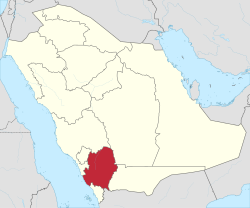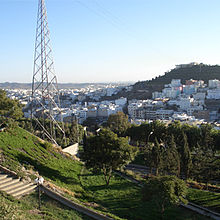Asir
Asir
| |
|---|---|
| Asir Province | |
Rijal Almaa Heritage Village Art Street, Abha Al Maqar Palace, Al-Namas Al Hawzah Heritage Village, Dhahran Al Janub Habala Valley | |
 Map of Saudi Arabia with ʿAsīr highlighted | |
| Coordinates: 19°0′N 43°0′E / 19.000°N 43.000°E | |
| Country | |
| Capital | Abha |
| Boroughs | 13 |
| Government | |
| • Governor | Turki bin Talal bin Abdulaziz Al Saud |
| Area | |
| • Total | 76,693 km2 (29,611 sq mi) |
| Population (2022 census) | |
| • Total | 2,024,285 |
| ISO 3166-2 | 14 |
| Website | ars discoveraseer |
Asir,[a][b] officially the Asir Province,[c] is a province in the southwest of Saudi Arabia, which is named after the ʿAsīr tribe. It has an area of 76,693 square kilometres (29,611 sq mi), and an estimated population of 2,024,285 (in 2022).[1] ʿAsīr is surrounded by Mecca Province to the north and west, Al-Bahah Province to the northwest, Riyadh Province to the northeast, Najran Province to the southeast, and Jazan Province and the Yemeni Muhafazah (Governorate) of Saada to the south.
Abha is the provincial capital, and other towns include Khamis Mushait, Bisha and Bareq. The regional governor is Turki ibn Talal bin Abdulaziz Al Saud. He replaced his cousin, Faisal bin Khalid bin Abdulaziz Al Saud, after being appointed on 27 December 2018.[2]
Etymology
[edit]The origin of the name "Asir" remains a subject of debate among historians. One theory, proposed by Al-Masudi in his work The Meadows of Gold, suggests that the region was originally known as the "land of Azd".[3]
Another popular hypothesis suggests that the name "Asir" derives from the Arabic term ʿUsrah (Arabic: عُسرة, lit. 'Hardship'). This theory comes from the fact that the region's terrain is rugged, which can be challenging to navigate.[4]
A third perspective proposed by Fuad Hamza in his book Fi bilad ʿAseer, links the name to the historical prominence of Banu Asir.[5] As the tribe gained power and influence, its name came to encompass the surrounding territories and tribes.[5] This association was reinforced by the close ties between the Asir tribe and many of the ruling emirs in the region, including those from the Al Yazid, Al Muthami, and Al A'ad families.[5]
History
[edit]Ancient history
[edit]In 25 B.C., Aelius Gallus marched his legions south from Egypt on an expedition of 1,300 miles (2,100 kilometres), to take control of the ancient overland trade routes between the Mediterranean Sea and what is now Hadhramaut in Yemen. The Romans wanted control of those routes because they were desperate for money and hoped to raise some by capturing Ma'rib, capital of Sabaʾ, and taking control of the trade in incense – then a priceless commodity – and other valuable aromatics. As it turned out, however, the expedition was a disaster and little information about ʿAsir emerged.[6]
Modern history
[edit]By 1920, however, Ibn Saud, the founder of the modern Saudi state, had begun to recoup the losses of the House of Saud, and to unify most of the peninsula under his rule. As part of this campaign, he sent his Bedouin warriors also known as the Ikhwan to occupy ʿAsir, and the ruler of the region, Hasan Al Idrissi, had to leave.[7] Therefore, he asked for protection from Imam Yahya, the ruler of Yemen and went there.[7] From then on ʿAsir has been controlled by the House of Saud, a situation formalized in 1934 with the signing of the Treaty of Taʾif between Saudi Arabia and Yemen. Even then the region was still largely unknown to the West. In 1932, St John Philby, one of the first Europeans to explore and map the peninsula, did enter ʿAsir, but as he did not publish his observations until 1952, the area remained one of the blank spots on the world's map.[8] In 1935 ʿAsir was made a separate governorate.[9]
Mass shootings of Ethiopian refugees
[edit]Since 2014 refugees are killed after crossing the Saudi border by the Saudi Border Guard. Since 2023 at least several hundred Ethiopian refugees have been killed at the border between Yemen and the provinces Jazan, Asir and Najran. The Saudis have also used explosive weapons.[10][11]
Economy
[edit]Historically, ʿAsir was known for producing coffee, wheat, alfalfa, barley, senna, and frankincense.[12][13][14] Wheat was grown in the summer and sesame has been grown in wetter areas of the region.[13][15] Straw was used to make mats, hats, and baskets. Tribes in the area also wove tents from straw.[16]
Modern development projects
[edit]In 2019, the Saudi government launched an infrastructure development project in ʿAsir Region. The project is expected to cost more than 1 billion Saudi Riyals. The provided projects will include health care, transportation and municipal services.[17] The project is in line with the Saudi Vision 2030 to diversify non-petroleum income and activate new resources in Saudi Arabia.[17]
In 2023, Crown Prince Mohammed bin Salman launched Soudah Peaks Project to develop a tourism destination in Soudi Arabia's highest peak, Jabal Soudah.[18]
Geography
[edit]The ʿAsir Region is situated on a high plateau that receives more rainfall than the rest of the country and contains the country's highest peaks, which rise to almost 3,000 metres (9,800 ft) at Jabal Sawda near Abha. Though data is exceedingly sparse and unreliable, the average annual rainfall in the highlands probably ranges from 300–500 millimetres (12–20 in). It falls in two rainy seasons, the chief one being in March and April, with some rain in the summer. Temperatures are very extreme, with diurnal temperature ranges in the highlands the greatest in the world. It is common[clarification needed] for afternoon temperatures to be over 30 °C (86 °F), yet mornings can be extremely frosty and fog can cut visibility to near zero percent. As a result, there is much more natural vegetation in ʿAsir than in any other part of Saudi Arabia, with sheltered areas even containing areas of dense coniferous forests, though more exposed ridges still are very dry. ʿAsir is home to many farmers who chiefly grow wheat and fruit crops. Irrigation has greatly expanded production in modern times. Asir National Park was established in 1981, and extends from the Red Sea coast through the western foothills to the Asir escarpment.[19]
Demographics
[edit]| Year | Pop. | ±% p.a. |
|---|---|---|
| 1992 | 1,340,168 | — |
| 2004 | 1,687,939 | +1.94% |
| 2010 | 1,927,087 | +2.23% |
| 2022 | 2,024,285 | +0.41% |
| source:[20] | ||
Governorates
[edit]
The region is divided into sixteen governorates (with the populations of the Census of 2010):[21]
- Abha (+366,551)
- Muhayil (+228,979)
- An-Namas (+54,119)
- Billasmar (+34,080)
- Billahmar (+25,709)
- Balqarn
- Bareq (+74,391)
- Bishah (+205,346)
- Khamis Mushayt (+512,599)
- Rijal Almaa (+65,406)
- Tanomah (+40,000)
- Dhahran Al Janub (+63,119)
- Tathlith (+59,188)
- Sarat Ubaida (+67,120)
- Ahad Rafidah (+113,043)
- Al Majaridah (+103,531)
- Al Harajah
List of governors
[edit]- Turki bin Ahmed Al Sudairi (1900s–8 June 1969)[22]
- Fahd bin Saad bin Abdul Rahman (8 June 1969–1971)[22]
- Khalid bin Faisal (1971–2007)
- Faisal bin Khalid (2007–2018)
- Turki bin Talal (2018–present)
See also
[edit]- Al Soudah
- Soudah Peaks
- Rijal Almaa
- Al-Qatt Al-Asiri
- Hejaz
- Sarat Mountains
- Sarat Ubaida Governorate
- South Arabia
- Saleh Al-Qadhi
- Tihamah
Notes
[edit]References
[edit]- ^ "Population Characteristics surveys" (PDF). General Authority for Statistics. 2017.
- ^ "A number of Royal Orders Issued 9 Riyadh". The Saudi Press Agency. 27 December 2018.
- ^ Masʿūdī, ʿAlī Ibn-al-Ḥusain al-; Lunde, Paul; Masʿūdī, ʿAlī Ibn-al-Ḥusain al- (1989). The meadows of gold: the Abbasids. London: Kegan Paul Internat. ISBN 978-0-7103-0246-5.
Al-Sarah, the mountain of Azad, is called Al-Sarah, and it is also called Al-Hijaz, but it is called Al-Sarah from this mountain with its back.
- ^ "بوابة إمارة منطقة عسير - تسميتها بعسير". 2016-03-07. Archived from the original on 2016-03-07. Retrieved 2024-10-03.
- ^ a b c فؤاد حمزة. في بلاد عسير (in Arabic).
- ^ Jameson, Shelagh (1968). "Chronology of the Campaigns of Aelius Gallus and C. Petronius". The Journal of Roman Studies. 58: 71–84. doi:10.2307/299696. ISSN 0075-4358. JSTOR 299696.
- ^ a b Jerald L. Thompson (1981). H. ST. John Philby, Ibn Saud and Palestine (PDF) (Master of Arts thesis). University of Kansas. p. 31. Archived (PDF) from the original on January 29, 2021. Retrieved 4 June 2021.
- ^ Monroe, Elizabeth (1973). "Arabia. St John Philby's Contribution to Pre-Islamic Studies". Proceedings of the Seminar for Arabian Studies. 3: 29–35. ISSN 0308-8421. JSTOR 41223273.
- ^ A. Nassir Saleh (October 1975). The emergence of Saudi Arabian administrative areas: A study in political geography (PDF) (PhD thesis). Durham University. p. 76. Retrieved 5 June 2021.
- ^ Beaumont, Peter (2023-08-21). "'Fired on like rain': Saudi border guards accused of mass killings of Ethiopians". The Guardian. ISSN 0261-3077. Retrieved 2023-08-21.
- ^ "Saudi Arabia: Mass Killings of Migrants at Yemen Border". Human Rights Watch. 2023-08-21. Retrieved 2023-08-21.
- ^ Prothero, G.W. (1920). Arabia. London: H.M. Stationery Office. p. 83. Archived from the original on 2016-12-27. Retrieved 2016-08-15.
- ^ a b Prothero, G.W. (1920). Arabia. London: H.M. Stationery Office. p. 84. Archived from the original on 2016-12-27. Retrieved 2016-08-15.
- ^ Prothero, G.W. (1920). Arabia. London: H.M. Stationery Office. p. 86. Archived from the original on 2016-12-27. Retrieved 2016-08-15.
- ^ Prothero, G.W. (1920). Arabia. London: H.M. Stationery Office. p. 85. Archived from the original on 2016-11-15. Retrieved 2016-08-15.
- ^ Prothero, G.W. (1920). Arabia. London: H.M. Stationery Office. p. 99. Archived from the original on 2016-08-22. Retrieved 2016-08-15.
- ^ a b "Saudi Arabia to launch plan for multibillion infrastructure projects in Asir". Arab News. 2019-03-11. Retrieved 2019-03-12.
- ^ "Saudi crown prince launches 'Soudah Peaks' masterplan". Arab News. 2023-09-25. Retrieved 2024-03-12.
- ^ "Things to do in Asir Saudi Arabia | Asir National Park". ROAM: Experience Undiscover Worlds. Retrieved 2024-07-24.
- ^ "Saudi Arabia: Regions & Major Cities – Population Statistics, Maps, Charts, Weather and Web Information". www.citypopulation.de.
- ^ "board game".
- ^ a b Gary Samuel Samore (1984). Royal Family Politics in Saudi Arabia (1953–1982) (PhD thesis). Harvard University. p. 260. ProQuest 303295482. Retrieved 20 May 2021.
- Mackey, Sandra (2002) [1987]. The Saudis: Inside the Desert Kingdom. New York: W.W. Norton and Company. ISBN 0-393-32417-6. Updated Edition; Norton Paperback; pbk.
External links
[edit]- . Encyclopædia Britannica. Vol. 20 (11th ed.). 1911. p. 443.
- Asir National Park: Splendid Arabia, An Online Guide to the Kingdom of Saudi Arabia







